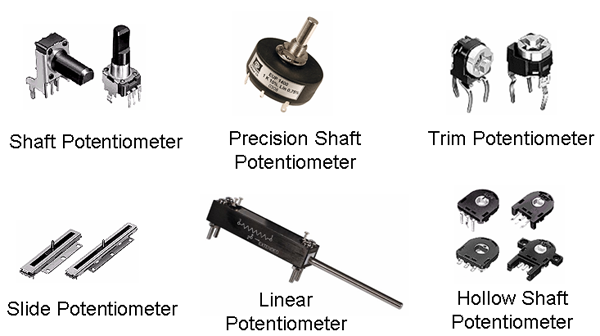Potentiometers (or pots) are variable resistors. They have three terminals with the center terminal being a center tap contact or “wiper” that slides across an element of constant resistance. As the wiper moves along the element, the resistance from the end terminals to the wiper changes.
Types of Pots
There are many different types of pots, though they usually have very subtle differences and can be hard to tell apart. Below are several common types of pots.
-
Shaft Potentiometer - The most common type, also come in high-precision versions. The shaft can be turned by hand or attached to some device. Some of these cannot turn complete circles while others can turn all the way (continuous turn). Some are also made to turn around multiple times (multi-turn) to sweep the entire resistance range.
-
Trim Pots - These pots are commonly attached to circuit boards when it may be necessary to add tuning to a circuit. They are very small and may require a small screwdriver to turn.
-
Linear & Slide Pots - These pots move in a linear motion. Slide pots are used for user-controlled tuning and would be found in such devices such as light dimmers. Linear pots are made to be mounted onto a device to measure linear position.
-
Hollow-Shaft Pots - These are used in place of shaft potentiometers when space is limited. They are very thin (~3mm) and mount around a rotating shaft.
Applications
A rotary potentiometer can be used to measure the rotation of a shaft. It is easiest to use if the shaft being measured does not need to rotate continuously, but rather has a range of motion of less than 360 degrees. You can attach the pot to a shaft via gears. By using a gear ratio other than 1:1, you can adjust the range of motion and precision of your angular sensor.
